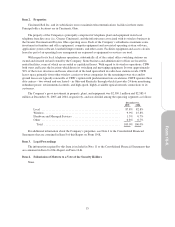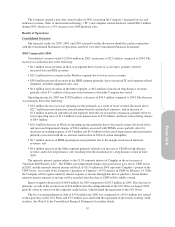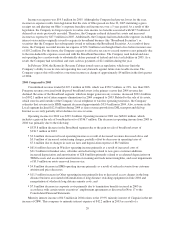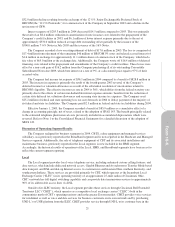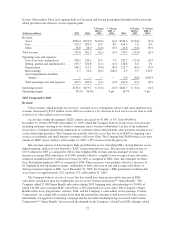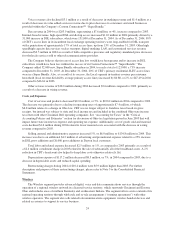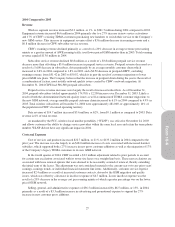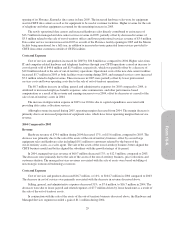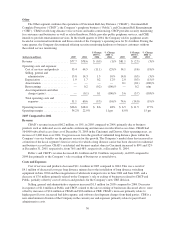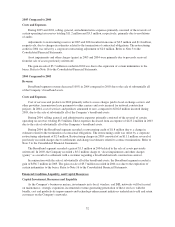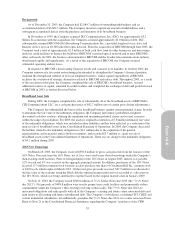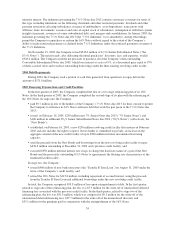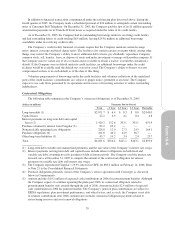Cincinnati Bell 2005 Annual Report Download - page 75
Download and view the complete annual report
Please find page 75 of the 2005 Cincinnati Bell annual report below. You can navigate through the pages in the report by either clicking on the pages listed below, or by using the keyword search tool below to find specific information within the annual report.
The Wireless segment consists of CBW, which was historically a joint venture with Cingular Wireless
Corporation PCS, LLC (“Cingular”), in which the Company owned 80.1% of CBW while Cingular owned the
remaining 19.9%. On February 14, 2006, the Company purchased Cingular’s interest such that CBW is now a
wholly-owned subsidiary.
Since October 2003, CBW has deployed service on both TDMA and GSM networks. As of December 31,
2005, CBW had transitioned more than 80% of its subscribers to GSM technology, which provides voice
communication, short message service (“SMS”) or text messaging, and enhanced data communication services,
such as mobile web browsing, internet access, email, and picture messaging. In the first quarter of 2005, the
Company completed its upgrade to enhanced data rates for GSM evolution (“EDGE”), which required only
software upgrades to deliver higher speeds of data transmission and capacity. The Company expects to
discontinue the use of its TDMA network during 2006.
(dollars in millions, except for
operating metrics) 2005 2004
$ Change
2005 vs.
2004
% Change
2005 vs.
2004 2003
$ Change
2004 vs.
2003
% Change
2004 vs.
2003
Revenue:
Service .................... $214.8 $242.0 $(27.2) (11)% $246.4 $ (4.4) (2)%
Equipment ................. 22.7 19.7 3.0 15% 13.1 6.6 50%
Total revenue ............... 237.5 261.7 (24.2) (9)% 259.5 2.2 1%
Operating costs and expenses:
Cost of services and products . . 129.3 133.2 (3.9) (3)% 110.5 22.7 21%
Selling, general and
administrative ............. 56.1 56.5 (0.4) (1)% 50.0 6.5 13%
Depreciation ................ 61.5 58.3 3.2 5% 38.3 20.0 52%
Amortization ............... — 9.1 (9.1) (100)% 0.5 8.6 n/m
Restructuring ............... — 0.1 (0.1) (100)% — 0.1 n/m
Asset impairments and other
charges .................. 42.3 5.9 36.4 n/m — 5.9 n/m
Total operating costs and
expenses ................. 289.2 263.1 26.1 10% 199.3 63.8 32%
Operating income (loss) ......... $(51.7) $ (1.4) $(50.3) n/m $ 60.2 $(61.6) (102)%
Operating margin .............. (21.8)% (0.5)% (21) pts 23.2% (24) pts
Operating metrics
Postpaid ARPU* ............ $44.66 $50.92 $(6.26) (12)% $51.42 $(0.50) (1)%
Prepaid ARPU* ............. $19.62 $19.85 $(0.23) (1)% $19.24 $ 0.61 3%
* The Company has presented certain information regarding monthly average revenue per user (“ARPU”)
because the Company believes ARPU provides a useful measure of the operational performance of the
wireless business. ARPU is calculated by dividing service revenue, excluding roaming revenue, by the
average subscriber base for the period.
2005 Compared to 2004
Revenue
Service revenue decreased by $27.2 million in 2005 as compared to 2004. This decrease is primarily
attributed to the following:
•$22.4 million decrease in postpaid subscriber service revenue due to lower ARPU. The Company’s
postpaid ARPU decreased by $6.26 compared to 2004 due to lower priced GSM rate plans and bundling
plans, slightly offset by an increase in data revenues. The increase in subscribers from 306,300 at
December 31, 2004 to 315,100 at December 31, 2005 is the result of the Company’s efforts to recover
subscribers that were lost as a result of network quality problems encountered in 2004 at the early stages
of the Company’s network migration from TDMA to GSM. The Company has resolved the difficulties
25


